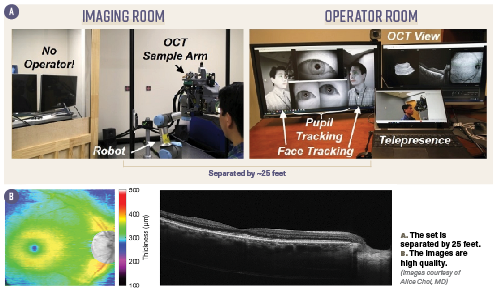Telemedicine enhanced by robotically aligned OCT
A pilot study tests the technology to obtain remote fundus imaging of patients.
Reviewed by Eun Young (Alice) Choi, MD.

Robotically aligned optical coherence tomography (RA-OCT) can provide high-quality volumetric retinal and optic nerve images of patients in the emergency department (ED), the findings of which correlated well with the clinical examinations, according to pilot study results presented at the Women in Ophthalmology 2021 Summer Symposium.
This technology has the potential to be useful in telemedicine, according to Eun Young (Alice) Choi, MD, and Anthony Kuo, MD, senior author and associate professor of ophthalmology at Duke University School of Medicine in Durham, North Carolina.
Patients who present to the ED with ocular injuries may need to undergo a fundus examination, but there are scenarios in which that need may not be met for various reasons. For example, using RA-OCT may meet that need in remote areas.
In a pilot study, Choi and her colleagues tested the ability of RA-OCT to obtain remote fundus imaging of patients who presented to the Duke University ED with ocular complaints.
Six patients (3 men, 3 women; age range, 24-84 years) were recruited for the study over the course of 6 nonconsecutive days. Patients who presented with penetrating ocular trauma or loss of blood were excluded.
The swept-source OCT machine provided a 32° field of view of the retina, including the fovea and optic nerve head. Rectangular volumes and full-width B-scans were acquired in triplicate. Thickness maps were generated with semiautomatic segmentation of selected volumes.
The ophthalmology resident on call evaluated the patients and documented the imaging findings and diagnosis.

The clinician who operated the RA-OCT during imaging of 2 patients was positioned behind a Plexiglas barrier 6 feet away from the patients. Another 4 patients underwent imaging while the operator was in a separate room that was connected remotely to the RA-OCT via a local network.
A trained reader who was masked to the examination reviewed the OCT images, according to Choi.
The investigators reported that the images they obtained were of high quality and agreed with the clinical examinations. The documented pathologies included drusen and retinal thinning. In cases in which the retinal appeared normal, soft drusen were seen on OCT images.
Although the pathologies imaged in the pilot study were limited to findings in only a few patients, Choi envisions a future for RA-OCT in telemedicine.
RA-OCT is an investigational device being used under a research protocol. The device was developed by Joseph Izatt, PhD, of Duke Biomedical Engineering; Mark Draelos, MD, PhD, of Duke Biomedical Engineering and Surgery; and Ryan McNabb, PhD, of Duke Ophthalmology.
Eun Young (Alice) Choi, MD
e: ec281@duke.edu
This article was adapted from Dr Choi’s presentation at the Women in Ophthalmology 2021 Summer Symposium, August 26-29, 2021, Amelia Island, Florida. Choi has no financial interest in this subject matter.
Anthony Kuo, MD
e: anthony.kuo@duke.edu
Kuo has no financial interest in this subject matter.
Related Content: Imaging | Ophthalmology | Diabetic Retinopathy